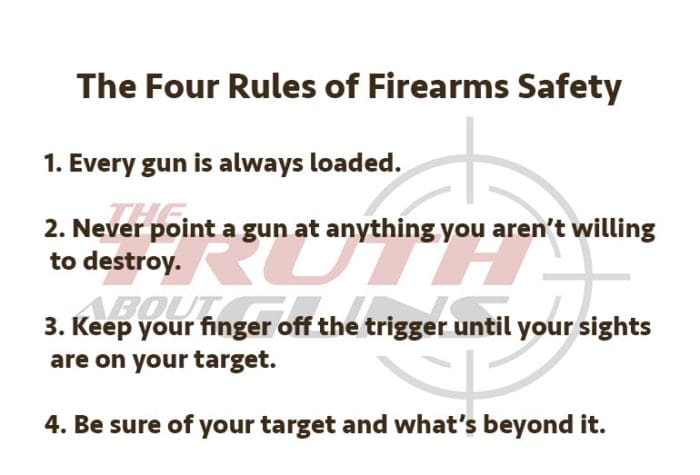The Four Rules of Gun Safety prevent firearms-related accidents — more accurately called “negligent discharges” or ND’s. Follow all four rules and you eliminate the possibility of creating a dangerous, perhaps even deadly ND. Click here for gun guru Jeff Cooper’s original Four Rules.
Here’s my take . . .
1. Every gun is always loaded
Safety demands that you treat all firearms as loaded — at least until you personally and accurately verify that a gun is unloaded. Always safety check a firearm before and after handling.
Safety check every gun immediately after you pick up, even if you put it down moments before. Safety check every gun immediately before you put it down or hand it to someone, even if you “know” it’s unloaded. Remember: you can remove a magazine from a firearm and still have a round in the chamber. You must check the chamber.
If someone hands you a gun, make sure it’s unloaded. If someone says “it’s unloaded” treat the statement as meaningless. The only unloaded gun is one you’ve personally checked and it’s been secured or hasn’t left your sight since you checked it. Until and unless you’ve safety checked a firearm — and in most cases (save cleaning) even then — assume the firearm is loaded.
2. Never point a gun at anything you aren’t willing to distroy
Also known as: always keep your gun pointed in a safe direction.
If you point a gun at an innocent person or an inoffensive inedible animal, bad things can happen. If you keep your gun pointed in a safe direction, away from innocent life, they can’t. Even if you have a negligent discharge — which will only occur if you violate the other safety rules — it won’t harm man or beast.
What’s a safe direction? Anyplace where the bullet couldn’t harm an innocent person or non-game animal should you fire the gun.
There may be times when there isn’t a safe direction.
Bullets can penetrate walls and other barriers and travel extremely long distances. Someone living in an apartment building in an urban area may not be able to avoid the possibility of a negligent discharge causing harm.
In that case as in all others — such as cleaning, storage and transportation — always keep a gun pointed in the safest possible direction. For example, aiming a gun at the steel-reinforced corners of a building may be an apartment dweller’s best bet.
3. Keep your finger off the trigger until your sights are on your target.
Guns don’t “go off.” Excepting older guns that aren’t “drop-safe” or a gun that’s mechanically defective (an extremely rare occurrence) someone or something has to pull the trigger for the gun to fire. If you keep your finger (and other bits) off the trigger, you won’t create a negligent discharge.
There’s a natural tendency to place your finger on a gun’s trigger; that’s the way firearms are designed to be held. You have to train yourself not to put your finger on the trigger until you’re ready to shoot.
When you take hold of a gun, pause. Place your finger in a safe spot (above the trigger on the gun’s frame). Feel your finger placement. Look at it. Lock it into your memory. Do this every time you hold a gun.
[NOTE: Even people with excellent “trigger discipline” may place their finger on a trigger in a high-stress situation. For this reason, some people choose handguns with a heavy trigger pull (e.g., revolvers) or a gun with a heavy first trigger pull followed by lighter trigger pulls.]
4. Be sure of your target and what’s beyond it.
Again, bullets can penetrate barriers and travel great distances before they lose lethal force. You can aim at one thing and hit another, with disastrous results.
Always make sure there’s no one downrange, or someone about to go downrange. How far downrange should you consider? As far as the eye can see — and then some (a .22 caliber bullet can travel a mile before losing momentum). Don’t forget the possibility of barrier penetration (e.g., there may be horses or people behind a distant barn).
Also keep in mind that you may inadvertently fire well to the left, right or above your target. Imagine a horizontal line running from where you’re standing to your right and left, trailing off into infinity. Make sure there’s no person or animal anywhere ahead of this “firing line” or about to go ahead of the line.
In terms of self-defense, assess your environment, preferably before you draw your gun and certainly after. Defensive gun training courses (especially force-on-force) and competition are helpful in this regard. In any case, accuracy is a function of distance. The closer you are to a target, the less likely you’ll miss and shoot an innocent bystander.
———
There are other gun safety rules (e.g. don’t drink and shoot). But master these Four Gun Safety Rules and you’ll enjoy a lifetime of safe gun handling.
